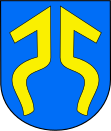Pińczów
| Pińczów | ||
|---|---|---|

|
|
|
| Basic data | ||
| State : | Poland | |
| Voivodeship : | Holy Cross | |
| Powiat : | Pińczów | |
| Gmina : | Pińczów | |
| Area : | 14.32 km² | |
| Geographic location : | 50 ° 31 ' N , 20 ° 32' E | |
| Height : | 257 m npm | |
| Residents : | 11,021 (Dec. 31, 2016) | |
| Postal code : | 28-400 | |
| Telephone code : | (+48) 41 35 | |
| License plate : | TPI | |
| Economy and Transport | ||
| Next international airport : | Krakow-Balice | |
Pińczów is a Polish district town in the Świętokrzyskie Voivodeship , between Krakow and Kielce on the Nida River. It is also the seat of a town-and-country municipality .
history
The place was first mentioned in 1405. In 1428 King Władysław II Jagiełło gave the place as Piędziców city rights. In the 16th century it was next to Raków the second important center of the Polish Reformation and before Raków (German: Rakau ) the headquarters of the Polish Unitarians . Because of its importance for intellectual life, it was sometimes called "Polish Athens". At that time the famous sculpture workshop of the Italian Renaissance artist Santi Gucci was active in the city . As a result of the Third Partition of Poland in 1795, Pińczów became Austrian. From 1815 Pińczów belonged to the Russian Congress Poland .
During the Second World War, the city and its surroundings were the scene of fierce fighting between the German occupiers and Polish partisan units. In July and August 1944, the German troops were temporarily driven out by the Home Army , which brought a Pińczów Republic into being. The war left the city 80 percent destroyed.
From 1975 to 1998 the city was part of the Kielce Voivodeship .
local community
The town-and-country community ( gmina miejsko-wiejska ) includes the town of Pińczów and 41 school departments ( sołectwo ).
Attractions
Anna Chapel
The St. Anne's Chapel (Kaplica św. Anny) was in 1600 on the St. Anne's hills of the city by architect Santi Gucci built. The chapel has a rectangular plan and is an example of Mannerist architecture . The chapel, which has a balcony on its dome, was donated by the Schlachzitzen Zygmunt Myszkowski .
More Attractions
- Franciscan monastery complex
- Former Pauline monastery with St. John the Evangelist Church
- Wielopolski Palace
- Castle ruins from the 15th / 16th centuries century
- Synagogue from the 16th century
- Sanctuary of Our Lady of Mirowo
Town twinning
Sister cities of Pińczów are
sons and daughters of the town
- Peter Statorius the Elder J. (around 1565–1605), writer and theologian
- Czesław Olech (1931–2015), mathematician
- Artur Dutkiewicz (* 1958), jazz musician
People related to the city
- Francesco Negri (1500–1563), Benedictine monk, humanist, teacher, writer and reformer in Chiavenna and Poland
literature
- Pińczów , in: Guy Miron (Ed.): The Yad Vashem encyclopedia of the ghettos during the Holocaust . Jerusalem: Yad Vashem, 2009 ISBN 978-965-308-345-5 , pp. 587f.
Web links
Individual evidence
- ^ Siegfried Wollgast: Morphology of Silesian Religiosity in the Early Modern Age: Socinianism and Anabaptism. In: Würzburg medical history reports. Volume 22, 2003, pp. 419-448, here: pp. 423 f.
- ↑ See also archived copy ( memento of the original from March 13, 2008 in the Internet Archive ) Info: The archive link was inserted automatically and has not yet been checked. Please check the original and archive link according to the instructions and then remove this notice.
- ^ City website , accessed October 6, 2017

